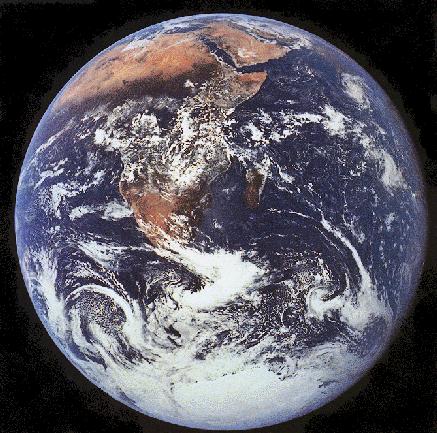Contemporary (popular-)scientists tend to place themselves somewhere in space, inside our solarsystem, when they describe the formation of the earth. We watch the 3rd planet from the sun, the "blue planet", spinning through space. On that planet we see strange developments happening. At the "surface" we find some sort of "primordial soup", a dense atmosphere where frequent lightning and vulcanic activity cause all kinds of chemical reactions. This way the building blocks for primitive lifeforms could have been formed. Later this atmosphere gets lighter, oceans of water are forming in which life can further develop; bacteria, plankton, algae, jelly-fish, molluscs, fish.
In the mean time land starts to emerge and dry up. There also life catches on; fern, grass, trees, flowers. And animal life; insects, reptiles, and also mammals. And at last there appears a creature that wants to explain how this all came about, and why; and that's us.
In mythology there are many stories about how the earth was made. Most are miles away from what "we" now "know" about this. One story however stands out; the first creation story from the Jewish tradition*. But here also we find some incomprehensible issues; there is light, before the sun appears, for example. Here again I am intrigued by the "point of view" from where the writer describes everything. Imagine that you want to describe the developments of the earth not from outer-space, but from the surface of the planet itself? From the place where the audiance, the reader, is situated; how would the story be then?
First there is a period that you are in the midst of the dense "primordial soup"; scarcely distinction between gas and liquid, dense clouds all around. No land, no light; no sun, moon or starts. Steadily the soup grows thinner; the light can penetrate some what, there is a difference between night and day.
After some time the dense cloud cover gets separated from the liquid, which starts looking more and more like an ocean. Then slowly dry land emerges; the seas get separated from the land. On the land the vegetation starts developing. The cloud cover opens up; through the holes the sun, moon and stars become visible.
Now animal life is appearing; first in the sea, then also on land and in the air. Mammals come in the picture, and finally also the human species. It is not my intention to "prove" that the Bible is right after all. What fascinates me is the position from which the story is written. I don't believe that in the ancient times anybody could have dreamed up a story that can get so close to present-day hypothesis. And no man was whitness to the making of the earth. I believe that the Creator Himself has inspired the writer to write this story, even though the writer could not understand it himself. In doing this, the Creator did not position Himself somewhere distant in outer space, but He placed Himself next to the writer. He describes His actions such as a human would have experienced it if he would have been present. This is the fascinating truth in the Bible, that the Eternal One comes towards mankind, by his side, inside his skin. And this starts right there, at the first page...
* can be read in the bible, first book Genesis, first chapter.

|
